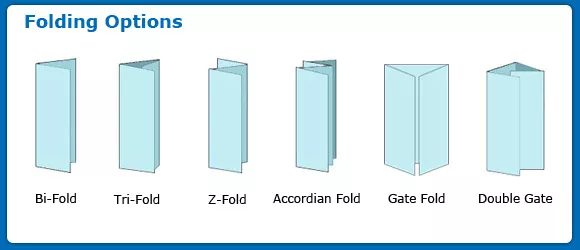Understanding folding: 6 layout options

How can I fold thee? Let me count the ways.
Ignore the Shakespeare references – instead, picture a brochure (pamphlet, leaflet).
These days brochures can come in all manner of shapes and sizes.
Think of pamphlet folding like entry level origami – a brochure reduces the overall size of the paper, but has the same amount of space for your information.
If you’re thinking about creating a brochure, here’s a quick introduction to the most common folds people request for their brochures... - but the opportunities are endless!
Which fold style will suit your brochure?
Read on to find out about the ideal use for each fold style.
1. Bi-fold (half-fold)
The half-fold is one of the most common and simple folds, similar to the way a book opens and closes. This is a great brochure fold for event programs, take-out menus, or handouts because it's quick to use, and doesn't fold up on itself like some of the other brochures do.
2. Tri-fold
The tri-fold brochure is the same size as a standard envelope and has a font cover or panel, with two other panels folding neatly inside. Tri-fold brochures are arguably the most durable pamphlets, as the internal leaves are nicely protected - they're great if you'd like your pamphlet to stand the test of time.
3. Z-fold
This fold also has three panels, but they’re folded back and forth to create a ‘Z’. A Z-fold brochure opens from left to right, so the reader will see all three panels at once – this makes it a great option for giving step-by-step information or instructions.
4. Accordion fold
Accordion fold is much like the Z, only it will typically have more than three folds, so it opens like a fan. You’ll often see maps use this fold, as it's really best for reducing large paper sizes (see more on paper sizes below)
5. Gate fold
The left and right edges of the gated fold come inward, meeting in the middle of the page. Opening a gate-folded leaflet feels elegant when you open it (like swinging open the doors to a beautiful ballroom), so it's perfect for more formal brochures.
6. Double gate
The double gate is identical to the standard gate fold, but has has four panels. Great if you've got plenty to say, or complex information to share, but not ideal if you 'd like to get your information across quickly.

